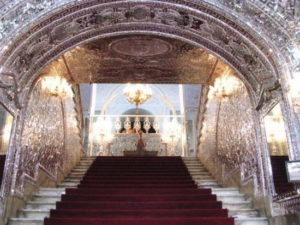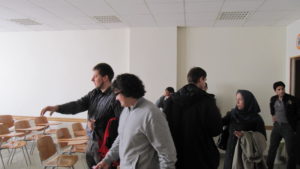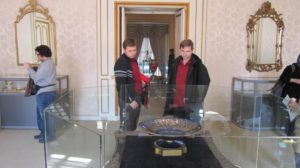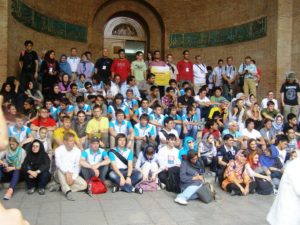The Iranian plateau today is a land surrounded by high mountains and spotted by warm lowlands. Two important mountain ranges, each with peaks over 5,000 meters high, stretch from the northwestern corner of the plateau, the current Azerbaijan province, to the south and east. The eastern branch, Alborz, boasts the highest peak of the two ranges, Mt. Damavand. The Alborz range creates a high barrier south of the Caspian Sea, making serious impacts on the climate of the plateau. While lush forests and pastures abound south of the Caspian and give it a mild, humid weather, the Alborz prevents the passing of the rain-rich clouds to the inside of the plateau, causing very low rainfall, and thus creating a dry and mostly warm climate south of the mountains.
- Do you know Iranian Culture
- What about foods in Iran
- About several ancient monuments
In Iran the lower status person issues the first greeting. In the reverse logic of ta’arof this means that a person who wants to be polite will make a point of this, using the universal Islamic salaam or the extended salaam aleikum. The universal phrase for leave-taking is khoda hafez —”God protect.” Greetings tend to be affectionate. Men kiss other men and women kiss other women at social events. If they meet on the street, a handshake is the more common greeting, not the opposite sex. The most common greeting amongst Iranians is “salaam alaykum” or more simply “salaam” (peace).
Physical contact between members of the opposite sex is assiduously avoided except between relatives. When being introduced to Iranians you may find that introductions are restricted to members of the same sex since it is often the custom for men and women to socialize separately.
It is good form to offer a portion of what one is about to eat to anyone nearby, even if they show no interest. One sees this behavior even in very small children. It is polite to refuse such an offer, but the one making the offer will be sensitive to the slightest hint of interest and will continue to press the offer if it is indicated.
If you are invited to an Iranian’s house then you should check to see if the host is wearing shoes. If not, remove yours at the door. On arrival, you should expect to be shown into the guests’ room. You should also try to arrive at the invited time as punctuality in Iran is appreciated.
The vast majority of Iranians are Shi’a Muslims, important religious minorities have always played an important role in Iranian life. Zoroastrians date back to the Achaemenid Empire more than two thousand years ago.
Many people like to visit the wonderful array of mosques in Iran. However it is important to take note of some basic mosque etiquette. The main custom for visiting a mosque in Iran is to remove your shoes before going inside on the carpet. If unsure just observe others and follow them. It is also another custom in mosques in Iran to dress modestly so that your body and limbs are covered. Women must cover their hair and not expose anything above their ankles. Men should not wear shorts. In some mosques the caretaker provides visitors with a long robe when their clothes are inappropriate for the mosque.
You should not talk loudly in a mosque as this is a place of worship. If someone is praying, do not under any circumstances walk directly in front of them. Many people will not appreciate having their pictures taken during worship.
All the food in Iran as an Islamic country are halal and alcohol is not allowed to serve in any places.
Geographical Position, Isfahan
The province of Isfahan covers an area of approximately 107,027 square kilometers and is situated in the center of Iran. To its north, stand the Markazi (Central) Province and the provinces of Qom and Semnan. In the south, it is within the limits of the provinces of Fars, Kohkiluyeh and Booyer Ahmad. Eastwards, it is in the neighborhood of the provinces of Khorassan and Yazd. Whereas, in the west it has common borders with the provinces of Lurestan and Chahar Mahal and Bakhtiyari.
Climate, Isfahan
Isfahan province experiences a moderate and dry climate on the whole, ranging between 40.6° C (being the maximum on a hot summers day), and the minimum being 10.6° C on a cold day in the winter season. The average annual temperature has been recorded as 16.7° C. and the annual rainfall on an average has been reported as 116.9 millimeters. The city of Isfahan experiences an excellent climate, with four distinct seasons that are apparent.
History and Culture, Isfahan
Historians have come to record Isfahan as a defense and military base. The security and protection of which was guaranteed by the increase of the number of castles, thereby, promoting the protection of the residents of the cities. These historical castles are Atashgah, Sarooyieh, Tabarok, Kohan Dej, Gard Dej etc. to name a few.
The great Shah Abbas I unified Persia, and with it created the grandeur of Isfahan. It even got the nickname Nesf-e-Jahan, meaning Half the World; to see Isfahan was to see half the world and no one leaves Isfahan without having marvelled at its architectural masterpieces. The highlights are Imam Square, with the mighty Imam Mosque, and the bridges crossing the Zayandeh Rud river.
Imam Square in Isfahan is one of the worlds largest squares, and also ranks among the most beautiful. One can easily spend several days just exploring the square, as well as the two mosques, the palace and the bazaar surrounding the square.
Iran Bastan Museum
There is a three dimensional map at the beginning of the hall of the first Building on which one can see all parts of Iran. Then, very ancient collections of potteries are displayed beginning from the 5th millennium B.C, decorated very uncomplicatedly. The potteries are in three different colors: red, buff and black. There are also various types of seals, clay tablets, figurines and ornaments. Bone-made and alabaster-made objects are also on display.

The next series of objects are bronze works of the north, northwest and Luristan province. In Luristan bronze works’ section, there can be visited samples of various kinds of objects used either in everyday life or ceremonies.
Golestan Palace Museum
Golestan Palace Museum is located at Arq Square. The oldest of the historic monuments in Tehran, the Golestan Palace (Palace of Flowers) belongs to a group of royal buildings .The Arg was built during the reign of Tahmasb I (r. 1524-1576) of the Safaviddynasty (1502-1736), and was later renovated by Karim Khan Zand (r. 1750-1779). Agha Mohamd Khan Qajar (1742-1797) selected Tehran as his capital. The Arg became the site of the Qajar (1794-1925). Court and Golestan Palace became the official residence of the royal family.

Everyone realizes why a new common language would be desirable: one could refuse to pay expensive translators. To achieve this, it would be necessary to have uniform grammar, pronunciation and more common words.

Persian Young Physicists’ Tournament, PYPT, is one of the programs which Iran has been involved since 2007 and two selected teams participate in IYPT and AYPT each year to get more experience in physics. Ariaian Young Innovative Minds Institute (AYIMI) as IYPT representative in IRAN (نماینده انحصاری) is the organizer of PYPT and has been succeeded to host IYPT 2011 in I.R.Iran. It is now a good experience for both teachers and students to improve their learning in physics.
Ariaian Young Innovative Minds Institute (AYIMI) and Amirkabir University of Technology (AUT) was the host of the 24th International Young Physicists’ Tournament (IYPT) from 22 to 31 July, 2011 in Tehran, Iran. The Executive Office of the Tournament at the AUT was the Iranian School of Health Physics, Faculty of Nuclear Engineering and Physics.
The Participation in this great tournament, Physics World Cup, created a unique opportunity for the top high school students to present their knowledge and to learn more about physics and related topics. Learning basic sciences specifically physics will help to promote our understanding of elements of our universe and human life. The organizers welcomed all the team members from the 23 participating countries around the world to Tehran, Iran; a country of old culture, old civilization and hospitable people. Iran has the greatest pioneering scholars of the world like Avicenna, Khwarizmi, Zakaria Razi, Omar Khayyam, Farabi, Birooni, and… as well as those who brought their philosophy, knowledge and understanding of the universe versus poetry like Molana, hatef Isfahani, etc.
The 24th IYPT, July 22-31, 2011, Tehran- Iran
We are glad to inform that the following countries have done the first step of registration in IYPT 2011 .
Croatia, Nigeria, Kenya, Poland, China, Austria, Slovakia ,Russia, Sweden, Singapore, Belarus, Mexico, Taiwan, Georgia, Bulgaria, Germany, Korea, Brazil , Switzerland, Czech Republic,Thailand,Ukrain, and Pakistan as the visitor.
The 1st visa was issued for Czech Republic team at the end of May.
1st Workshop in 2009
The 1st workshop was organized by Ariaian Young Innovative Minds (AYIMI) with cooperation of Scientific Societies of Amirkabir University of Technology (AUT) in 2009 to introduce different scientific activities such as IYPT and PYPT.
2nd Workshop in 2010
The 2nd workshop was in November 2010 to educate students and teachers how prepare themselves and their teams to attend PYPT and IYPT.
Ariaian Young Innovative Minds Institute (AYIMI) held IYPT 2011 EC meeting in Tehran on November 25-29 .On Nov. 25 they visited one of the Muesums’ palace in north of tehran, Saad Abad Muesume and on Nov 26 in the morning Martin Plesch, Dina Izadi, John Balcombe, Georg Hofferek and Timotheus Hell started the EC Meeting.


They talked about:
1- IYPT 2011 Iran 2. FP7 project for IYPT
3. Finances of IYPT, support for the EC meeting, refund of web page hosting costs 4. IOC members definition in statutes 5. Observer condition for participation of new countries in IYPT 6. IYTP tool kit, further reading material for IYPT, publication policy 7. Jurors in IYPT 8. Update of grading sheets 9. Questionnaire IYPT 2010 and plans for IYPT 2011 10. Visitors and guests at the tournament, policy 11. IYPT archive 12. IYPT journal 13. Web page 14. Any other business
After Tournament all the team members except Singapore, Kenya , Thailand and some members of Chinese’s took part in Isfahan tour on July 29 and 30. Unfortunately the disorganized tour caused IOC members miss two sessions of their meetings . The first and last meeting was on 29th July in Safavi Hotel . It started from 8:30 in the morning and continued until about 14:00. The problems for IYPT 2012 were discussed an Dr. Rudolf Lehn proposed the hosting of IYPT 2012 in Bad Saulgau , Germany.


اعضای داوران بین المللی Jurors
برنامه زمانبندی و کشورهای شرکت کننده در کتابچه مسابقه IYPT 2011 Booklet
